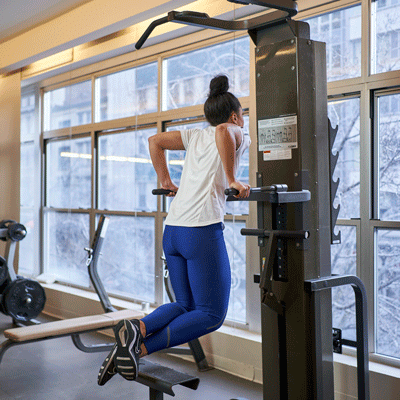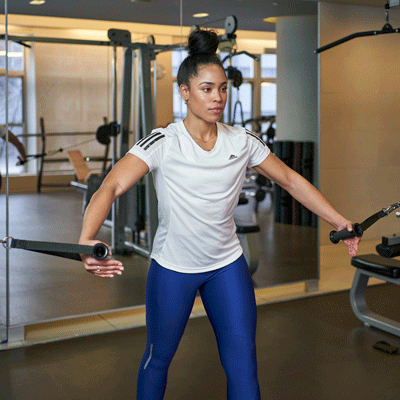Try these five essential exercises for gym or home to build and define your lower chest effectively.
Pecs (aka the pectoral muscles) are formed by two muscles — the Pectoralis major and the Pectoralis minor. The major makes up most of the lower chest muscles. The minor is a lot smaller and is located beneath the major.
A strong lower chest isn’t just about popping your pecs like Terry Crews (though NGL, that’s hella impressive). You need your lower chest to rotate and extend your arms. Here’s a deep dive into the five best lower chest exercises to help you get stronger, more defined pecs.
Best lower chest exercises
The five best lower chest exercises for defined pecs are:
Here’s a step-by-step guide to the five best lower chest exercises.
1. Chest dip
Muscles worked/benefits
- triceps
- pecs
- anterior deltoids (front shoulder muscles)
- latissimus dorsi
Equipment needed
Any of these options will work for chest dips:
- tricep dip machine/station
- dip bar
- parallel bars
- power tower
Psst. If you don’t have access to a machine, the parallel bars at a playground will do.
Steps
- Grasp a parallel bar or the handles of a dip station.
- Raise your body but keep your elbows soft.
- Lean your chest forward and keep your feet behind your body.
- Lower your body until triceps are parallel with the bar.
- Press back up into the raised position.
- Lower and repeat.
Tips for proper form
- Keep your elbows pointed slightly outward and try not to lock them.
- You’ll get a better tricep workout if you keep your feet underneath or in front of your body.
2. Cable crossover
Muscles worked/benefits
- pectoralis major
- anterior deltoids
- latissimus dorsi
Equipment needed
You’re gonna need a cable machine for this one.
Steps
- Place the pulleys in a high position and choose a mid-range weight.
- Hold a handle in each hand.
- Take a step forward and plant your foot firmly into the ground.
- Lean your torso forward and engage your core.
- Extend your hands in a wide arc and breathe in.
- Bring your hands toward the midline of your body for one complete repetition.
- Repeat.
Tips for proper form
- Keep your elbows soft (a slight bend) to take pressure off of the biceps.
- A higher pulley position targets the lower pecs more than the upper.
- You should feel a stretch in your chest, but don’t push it too far.
3. Decline bench press
Muscles worked/benefits
- lower pectoralis major
- anterior deltoid
- biceps brachii
- latissimus dorsi
Equipment needed
You’ll need a bench and barbells or dumbbells for this exercise.
Steps
- Adjust the bench to a decline angle (so your head is lower than your hips).
- Lie down on the bench and position your head beneath the barbell.
- Grasp the barbell with your palms facing forward a little more than shoulder-width apart.
- Lift the bar off the rack and slowly lower it to a position just beneath the nips.
- Slowly raise the bar to the starting position.
- Repeat.
Tips for proper form
It’s very easy to overwork the anterior deltoid (front shoulder muscles) with this exercise. Keep the weight light and the reps high to prevent shoulder pain.
4. Incline push up
Muscles worked/benefits
- pectoralis major
- anterior deltoid
- triceps brachii
- biceps brachii
The incline push-up mimics the decline bench press. This move is typically considered an easier version of a full push-up, but it’s still a great way to target the lower chest.
Equipment needed
Get crafty with it! You can use a bench, chair, or even a sturdy box.
Steps
- Start with a surface that’s at a 15- to 30-degree angle.
- Place your hands at the same level as your shoulders.
- Lower your body with bent elbows until your chest touches the bench.
- Push up and straighten your arms until you come back to start.
- Repeat.
Tips for proper form
- Create a straight line from your heels to the top of your head.
- The closer you are to the ground, the harder the push up will be.
- Don’t let your hips sag or stick out into the air.
5. Seated machine fly
Muscles worked/benefits
- pectoralis major
- biceps brachii
- serratus anterior
Equipment needed
- seated fly machine
Steps
- Adjust the fly machine handles so that your wrists, elbows, and shoulders are on the same plain.
- Grip the handles and press them toward your body’s midline.
- Slowly return the handles to the starting position.
- Repeat.
Tips for proper form
- Start with a lower weight than you think you need, so you don’t overstretch or load the shoulders.
- Use slow controlled movements.
- Keep your elbows bent, like you’re hugging a beach ball.
- When you begin, reach both arms back to grab the first handle and pull it to center. Then, reach back and grab the second handle and bring it to the center. This protects your shoulders and reduces your risk of an injury.
Sweet pec definition isn’t the only perk of working the lower chest. Other benefits include:
- enhanced shoulder stability
- contributes to overall strength
- can help improve posture
- increases range of motions in the shoulders and arms
- strengthening and lengthening of chest muscles (which can support better breathing)
These tips can keep your lower chest workouts effective and safe.
- Always warm up. A solid 10-minute warmup preps your muscles to give their all during your lifts.
- Do gentle stretches. A few gentle wall stretches after your warmup can reduce your risk of injury.
- Consider muscle balance. Don’t put all of your focus on a single muscle group. Maintain balance between the front and back of the body by doing a superset. This should include a lower chest lift followed by a lift that targets the latissimus dorsi, rhomboids, or trapezius.
- Sets and reps. Do enough sets and reps that the muscles are fatigued (not in pain) by the final rep.
- Alternate pec muscles. Work the pecs 2 to 3 times per week. Be sure to alternate between the lower, mid-, and upper chest.
Whether you want better pec definition or are focused on strength, these five lower chest exercises can get you to your goals. Just be sure you keep your workouts varied and give your body time to bounce back after each workout.






